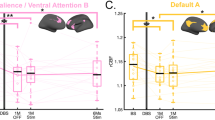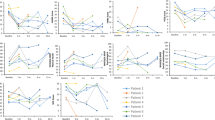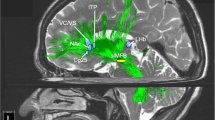Abstract
Deep brain stimulation (DBS) in the subgenual cingulated gyrus (SCG) is a promising new technique that may provide sustained remission in resistant major depressive disorder (MDD). Initial studies reported a significant early improvement in patients, followed by a decline within the first month of treatment, an unexpected phenomenon attributed to potential placebo effects or a physiological response to probe insertion that remains poorly understood. Here we characterized the behavioural antidepressant-like effect of DBS in the rat medial prefrontal cortex, focusing on modifications to rodent SCG correlate (prelimbic and infralimbic (IL) cortex). In addition, we evaluated the early outcome of DBS in the SCG of eight patients with resistant MDD involved in a clinical trial. We found similar antidepressant-like effects in rats implanted with electrodes, irrespective of whether they received electrical brain stimulation or not. This effect was due to regional inflammation, as it was temporally correlated with an increase of glial-fibrillary-acidic-protein immunoreactivity, and it was blocked by anti-inflammatory drugs. Indeed, inflammatory mediators and neuronal p11 expression also changed. Furthermore, a retrospective study indicated that the early response of MDD patients subjected to DBS was poorer when they received anti-inflammatory drugs. Our study demonstrates that electrode implantation up to the IL cortex is sufficient to produce an antidepressant-like effect of a similar magnitude to that observed in rats receiving brain stimulation. Moreover, both preclinical and clinical findings suggest that the use of anti-inflammatory drugs after electrode implantation may attenuate the early anti-depressive response in patients who are subjected to DBS.
This is a preview of subscription content, access via your institution
Access options
Subscribe to this journal
Receive 12 print issues and online access
$259.00 per year
only $21.58 per issue
Buy this article
- Purchase on Springer Link
- Instant access to full article PDF
Prices may be subject to local taxes which are calculated during checkout





Similar content being viewed by others
References
Hamani C, Mayberg H, Snyder B, Giacobbe P, Kennedy S, Lozano AM . Deep brain stimulation of the subcallosal cingulate gyrus for depression: anatomical location of active contacts in clinical responders and a suggested guideline for targeting. J Neurosurg 2009; 111: 1209–1215.
Lozano AM, Mayberg HS, Giacobbe P, Hamani C, Craddock RC, Kennedy SH . Subcallosal cingulate gyrus deep brain stimulation for treatment-resistant depression. Biol Psychiatry 2008; 64: 461–467.
Mayberg HS, Lozano AM, Voon V, McNeely HE, Seminowicz D, Hamani C et al. Deep brain stimulation for treatment-resistant depression. Neuron 2005; 45: 651–660.
Greenberg BD, Malone DA, Friehs GM, Rezai AR, Kubu CS, Malloy PF et al. Three-year outcomes in deep brain stimulation for highly resistant obsessive-compulsive disorder. Neuropsychopharmacology 2006; 31: 2384–2393.
Mallet L, Polosan M, Jaafari N, Baup N, Welter ML, Fontaine D et al. Subthalamic nucleus stimulation in severe obsessive-compulsive disorder. N Engl J Med 2008; 359: 2121–2134.
Maltete D, Chastan N, Derrey S, Debono B, Gerardin E, Lefaucheur R et al. Microsubthalamotomy effect at day 3: screening for determinants. Mov Disord 2009; 24: 286–289.
Holtzheimer PE, Kelley ME, Gross RE, Filkowski MM, Garlow SJ, Barrocas A et al. Subcallosal cingulate deep brain stimulation for treatment-resistant unipolar and bipolar depression. Arch Gen Psychiatry 2012; 69: 150–158.
Hirshler YK, Polat U, Biegon A . Intracranial electrode implantation produces regional neuroinflammation and memory deficits in rats. Exp Neurol 2010; 222: 42–50.
Ongur D, Price JL . The organization of networks within the orbital and medial prefrontal cortex of rats, monkeys and humans. Cereb Cortex 2000; 10: 206–219.
Takagishi M, Chiba T . Efferent projections of the infralimbic (area 25) region of the medial prefrontal cortex in the rat: an anterograde tracer PHA-L study. Brain Res 1991; 566: 26–39.
Paxinos G, Watson C . The Rat Brain in Stereotaxic Coordinates, Compact 6th edn. Academic Press: San Diego, CA, USA, 2009.
Hamani C, Diwan M, Macedo CE, Brandao ML, Shumake J, Gonzalez-Lima F et al. Antidepressant-like effects of medial prefrontal cortex deep brain stimulation in rats. Biol Psychiatry 2010; 67: 117–124.
Alba-Delgado C, Llorca-Torralba M, Horrillo I, Ortega JE, Mico JA, Sanchez-Blazquez P et al. Chronic pain leads to concomitant noradrenergic impairment and mood disorders. Biol Psychiatry 2013; 73: 54–62.
Puigdemont D, Perez-Egea R, Portella MJ, Molet J, de Diego-Adelino J, Gironell A et al. Deep brain stimulation of the subcallosal cingulate gyrus: further evidence in treatment-resistant major depression. Int J Neuropsychopharmacol 2011; 22: 1–13.
Svenningsson P, Chergui K, Rachleff I, Flajolet M, Zhang X, El Yacoubi M et al. Alterations in 5-HT1B receptor function by p11 in depression-like states. Science 2006; 311: 77–80.
Warner-Schmidt JL, Vanover KE, Chen EY, Marshall JJ, Greengard P . Antidepressant effects of selective serotonin reuptake inhibitors (SSRIs) are attenuated by antiinflammatory drugs in mice and humans. Proc Natl Acad Sci USA 2011; 108: 9262–9267.
Hamani C, Machado DC, Hipolide DC, Dubiela FP, Suchecki D, Macedo CE et al. Deep brain stimulation reverses anhedonic-like behavior in a chronic model of depression: role of serotonin and brain derived neurotrophic factor. Biol Psychiatry 2012; 71: 30–35.
Scopinho AA, Scopinho M, Lisboa SF, Correa FM, Guimaraes FS, Joca SR . Acute reversible inactivation of the ventral medial prefrontal cortex induces antidepressant-like effects in rats. Behav Brain Res 2010; 214: 437–442.
Slattery DA, Neumann I, Cryan JF . Transient inactivation of the infralimbic cortex induces antidepressant-like effects in the rat. J Psychopharmacol 2010; 25: 1295–1303.
Gersner R, Toth E, Isserles M, Zangen A . Site-specific antidepressant effects of repeated subconvulsive electrical stimulation: potential role of brain-derived neurotrophic factor. Biol Psychiatry 2010; 67: 125–132.
Hamani C, Diwan M, Isabella S, Lozano AM, Nobrega JN . Effects of different stimulation parameters on the antidepressant-like response of medial prefrontal cortex deep brain stimulation in rats. J Psychiatr Res 2010; 44: 683–687.
Warner-Schmidt JL, Flajolet M, Maller A, Chen EY, Qi H, Svenningsson P et al. Role of p11 in cellular and behavioral effects of 5-HT4 receptor stimulation. J Neurosci 2009; 29: 1937–1946.
Svenningsson P, Greengard P . p11 (S100A10)—an inducible adaptor protein that modulates neuronal functions. Curr Opin Pharmacol 2007; 7: 27–32.
Egeland M, Warner-Schmidt J, Greengard P, Svenningsson P . Co-expression of serotonin 5-HT(1B) and 5-HT(4) receptors in p11 containing cells in cerebral cortex, hippocampus, caudate-putamen and cerebellum. Neuropharmacology 2011; 61: 442–450.
Banasr M, Chowdhury GM, Terwilliger R, Newton SS, Duman RS, Behar KL et al. Glial pathology in an animal model of depression: reversal of stress-induced cellular, metabolic and behavioral deficits by the glutamate-modulating drug riluzole. Mol Psychiatry 2010; 15: 501–511.
Banasr M, Duman RS . Glial loss in the prefrontal cortex is sufficient to induce depressive-like behaviors. Biol Psychiatry 2008; 64: 863–870.
Gosselin RD, Gibney S, O'Malley D, Dinan TG, Cryan JF . Region specific decrease in glial fibrillary acidic protein immunoreactivity in the brain of a rat model of depression. Neuroscience 2009; 159: 915–925.
Miguel-Hidalgo JJ, Baucom C, Dilley G, Overholser JC, Meltzer HY, Stockmeier CA et al. Glial fibrillary acidic protein immunoreactivity in the prefrontal cortex distinguishes younger from older adults in major depressive disorder. Biol Psychiatry 2000; 48: 861–873.
Ongur D, Drevets WC, Price JL . Glial reduction in the subgenual prefrontal cortex in mood disorders. Proc Natl Acad Sci USA 1998; 95: 13290–13295.
Webster MJ, O'Grady J, Kleinman JE, Weickert CS . Glial fibrillary acidic protein mRNA levels in the cingulate cortex of individuals with depression, bipolar disorder and schizophrenia. Neuroscience 2005; 133: 453–461.
Jansson L, Wennstrom M, Johanson A, Tingstrom A . Glial cell activation in response to electroconvulsive seizures. Prog Neuropsychopharmacol Biol Psychiatry 2009; 33: 1119–1128.
Kragh J, Bolwig TG, Woldbye DP, Jorgensen OS . Electroconvulsive shock and lidocaine-induced seizures in the rat activate astrocytes as measured by glial fibrillary acidic protein. Biol Psychiatry 1993; 33: 794–800.
Czeh B, Simon M, Schmelting B, Hiemke C, Fuchs E . Astroglial plasticity in the hippocampus is affected by chronic psychosocial stress and concomitant fluoxetine treatment. Neuropsychopharmacology 2006; 31: 1616–1626.
Liu Q, Li B, Zhu HY, Wang YQ, Yu J, Wu GC . Clomipramine treatment reversed the glial pathology in a chronic unpredictable stress-induced rat model of depression. Eur Neuropsychopharmacol 2009; 19: 796–805.
De Leon M, Van Eldik LJ, Shooter EM . Differential regulation of S100 beta and mRNAs coding for S100-like proteins (42A and 42C) during development and after lesion of rat sciatic nerve. J Neurosci Res 1991; 29: 155–162.
Gveric D, Herrera BM, Cuzner ML . tPA receptors and the fibrinolytic response in multiple sclerosis lesions. Am J Pathol 2005; 166: 1143–1151.
Wu T, Angus CW, Yao XL, Logun C, Shelhamer JH . P11, a unique member of the S100 family of calcium-binding proteins, interacts with and inhibits the activity of the 85-kDa cytosolic phospholipase A2. J Biol Chem 1997; 272: 17145–17153.
Pawliczak R, Cowan MJ, Huang X, Nanavaty UB, Alsaaty S, Logun C et al. p11 expression in human bronchial epithelial cells is increased by nitric oxide in a cGMP-dependent pathway involving protein kinase G activation. J Biol Chem 2001; 276: 44613–44621.
Swisher JF, Burton N, Bacot SM, Vogel SN, Feldman GM . Annexin A2 tetramer activates human and murine macrophages through TLR4. Blood 2010; 115: 549–558.
Bayas A, Hummel V, Kallmann BA, Karch C, Toyka KV, Rieckmann P . Human cerebral endothelial cells are a potential source for bioactive BDNF. Cytokine 2002; 19: 55–58.
Kuno R, Yoshida Y, Nitta A, Nabeshima T, Wang J, Sonobe Y et al. The role of TNF-alpha and its receptors in the production of NGF and GDNF by astrocytes. Brain Res 2006; 1116: 12–18.
Saha RN, Liu X, Pahan K . Up-regulation of BDNF in astrocytes by TNF-alpha: a case for the neuroprotective role of cytokine. J Neuroimmune Pharmacol 2006; 1: 212–222.
Neto FL, Borges G, Torres-Sanchez S, Mico JA, Berrocoso E . Neurotrophins role in depression neurobiology: a review of basic and clinical evidence. Curr Neuropharmacol 2011; 9: 530–552.
Okuse K, Malik-Hall M, Baker MD, Poon WY, Kong H, Chao MV et al. Annexin II light chain regulates sensory neuron-specific sodium channel expression. Nature 2002; 417: 653–656.
Warner-Schmidt JL, Chen EY, Zhang X, Marshall JJ, Morozov A, Svenningsson P et al. A role for p11 in the antidepressant action of brain-derived neurotrophic factor. Biol Psychiatry 2010; 68: 528–535.
Masiakowski P, Shooter EM . Nerve growth factor induces the genes for two proteins related to a family of calcium-binding proteins in PC12 cells. Proc Natl Acad Sci USA 1988; 85: 1277–1281.
Miller AH, Maletic V, Raison CL . Inflammation and its discontents: the role of cytokines in the pathophysiology of major depression. Biol Psychiatry 2009; 65: 732–741.
Raison CL, Capuron L, Miller AH . Cytokines sing the blues: inflammation and the pathogenesis of depression. Trends Immunol 2006; 27: 24–31.
Buffo A, Rite I, Tripathi P, Lepier A, Colak D, Horn AP et al. Origin and progeny of reactive gliosis: A source of multipotent cells in the injured brain. Proc Natl Acad Sci USA 2008; 105: 3581–3586.
Vedam-Mai V, van Battum EY, Kamphuis W, Feenstra MG, Denys D, Reynolds BA et al. Deep brain stimulation and the role of astrocytes. Mol Psychiatry 2012; 17: 124–131, 115.
Acknowledgements
This study was supported by grants from the Spanish Ministry of Health; CIBERSAM G18, G19, G12 and G21, ‘Proyecto Intramural P91’ and PI10/01221, PI06/0662, PS09/00580, PI12/00915, CTS-7748, CTS-510, CTS-4303, FP7-PEOPLE-2010-RG (268377) and SAF2007-62378. We thank JM Lopez-Cepero and A Adell for helpful discussions. We also thank J Gallego-Gamo, R Rey-Brea and JA García-Partida for their excellent technical assistance in the animal study and J Berrocoso for his “Red Mice” software design.
Author information
Authors and Affiliations
Corresponding author
Ethics declarations
Competing interests
The authors declare no conflict of interest.
Additional information
Supplementary Information accompanies the paper on the Molecular Psychiatry website
Supplementary information
Rights and permissions
About this article
Cite this article
Perez-Caballero, L., Pérez-Egea, R., Romero-Grimaldi, C. et al. Early responses to deep brain stimulation in depression are modulated by anti-inflammatory drugs. Mol Psychiatry 19, 607–614 (2014). https://doi.org/10.1038/mp.2013.63
Received:
Revised:
Accepted:
Published:
Issue Date:
DOI: https://doi.org/10.1038/mp.2013.63
Keywords
This article is cited by
-
Opportunities and challenges for the use of deep brain stimulation in the treatment of refractory major depression
Discover Mental Health (2024)
-
Deep brain stimulation of the nucleus accumbens in treatment-resistant alcohol use disorder: a double-blind randomized controlled multi-center trial
Translational Psychiatry (2023)
-
Neuroinflammation mechanisms of neuromodulation therapies for anxiety and depression
Translational Psychiatry (2023)
-
Deep brain stimulation of the “medial forebrain bundle”: a strategy to modulate the reward system and manage treatment-resistant depression
Molecular Psychiatry (2022)
-
Deep brain stimulation of the “medial forebrain bundle”: sustained efficacy of antidepressant effect over years
Molecular Psychiatry (2022)



